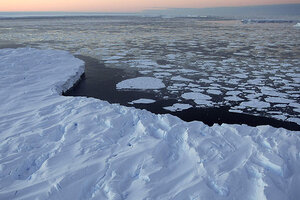What's to blame for melting Antarctic ice?
Like a hot beverage melts ice cubes, scientists have determined that warm ocean currents are thinning Antarctic ice.

Giant tabular icebergs surrounded by ice floe drift in Vincennes Bay in the Australian Antarctic Territory. Warm ocean currents appear to be thinning Antarctic ice, according to new research.
REUTERS/Torsten Blackwood/Pool
When it comes to melting ice shelves in Antarctica, the danger comes from below, new research suggests.
By discovering the anatomy of ice loss across this chilly expanse, research may be able to forecast how the continent will melt in the future — and also how much global seas may rise.
Team member David Vaughan, a scientist at the European Union initiative ice2sea, said this study "shows the key to predicting how the ice sheet will change in the future is in understanding the oceans."
Water or wind?
Scientists have long known that the wide platforms of ice extending from the southernmost continent have been shrinking away. But what's behind the melting hasn't been clear — whether warm ocean currents or surface winds have a bigger impact on the ice.
Now, a new satellite survey of Antarctica places the blame largely on the water. "In most places in Antarctica, we can't explain the ice-shelf thinning through melting of snow at the surface," said study team member Hamish Pritchard of the British Antarctic Survey in a statement. "So it has to be driven by warm ocean currents melting them from below." [Images: Tracking a Retreating Glacier]
The team's results represent the culmination of a massive international effort to observe the loss of Antarctic ice from the skies. Using NASA's ICESat satellite, the researchers closely monitored how the thickness of West and East Antarctica's ice changed over time. In some cases, Pritchard said, shelves thinned by as much as several meters each year. And the pattern of that melting, he added, suggested that at least 20 out of 54 observed platforms of ice across the continent were being melted largely by the oceans below, much like a warm drink consuming ice cubes.
While the exact factors driving the warming of Antarctic waters aren't known, scientists suggest that past toasty conditions in the tropics have created strong winds to the south in Antarctica, fueling ocean currents that bring hot water to the surface.
Glacier speed-up
Regardless, the trend spells trouble for the continent, the team said. That's because floating ice sheets act as a brake against the loss of Antarctica's land-bound rivers of ice, or glaciers. As these shelves melt away due to warming waters — mostly in West Antarctica — glaciers have begun to spill more and more ice into the seas.
"In all the cases where ice shelves are being melted by the ocean, the inland glaciers are speeding up," Pritchard said in a statement. "It's this glacier acceleration that's responsible for most of the increase in ice loss from the continent and this is contributing to sea-level rise."
It's a different story on the Antarctic Peninsula, the spit of ice just south of Argentina, however. Here, warm winds seem to be melting ice shelves from above, skimming layers of snow from the top.

